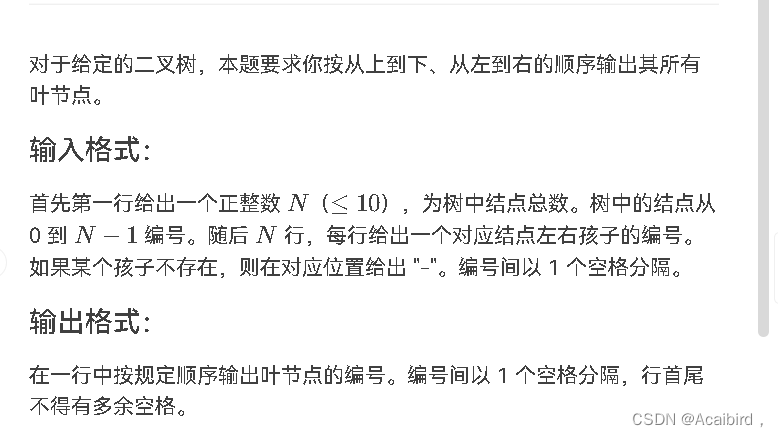题目:
样例输入:
8
1 -
- -
0 -
2 7
- -
- -
5 -
4 6
样例输出:1 4 5
想法:记录每个节点的左右节点,在操作
tuple<int, int> das[100]; //储存节点为i的左节点,右节点
bool vis1[20];//判断某个节点是否有father,没有的那就是head节点
queue<int> que;
int main(int args, char** argv)
{
/*ios::sync_with_stdio(false);
cin.tie(nullptr);
cin.tie(nullptr);*/
int n;
cin >> n;
ifor(i, 0, n - 1)
{
char c1, c2;
cin >> c1 >> c2;
if ( c1 ^ '-' )
{
get<0>(das[i]) = c1 - '0';
vis1[c1 - '0'] = 1;
}else
get<0>(das[i]) = -1;
if ( c2 ^ '-' )
{
get<1>(das[i]) = c2 - '0';
vis1[c2 - '0'] = 1;
}else
get<1>(das[i]) = -1;
}
for ( int i = 0; i <= n - 1; i++ )
{
if ( !vis1[i] )
{
que.push(i); break;
}
}
bool once = 1;
int cnt = 0;
// cout<<que.front()<<endl;
//层次遍历
while ( !que.empty() )
{
int tou = que.front();
que.pop();
int cnt=0;
//技巧:对于一个根节点i,以及他的左节点、右节点的二叉树而言,cnt=0,就代表她是叶节点
// cout<<get<0>(das[tou])<<" "<<get<1>(das[tou])<<endl;
if ( get<0>(das[tou]) ^ -1 )
{
que.push(get<0>(das[tou]));
cnt++;
}
if ( get<1>(das[tou]) ^ -1 )
{
que.push(get<1>(das[tou]));
cnt++;
}
if ( !cnt )
{
if ( once ) {
cout << tou;
once = 0;
}
else
cout << " " << tou;
}
}
return 0;
}

























 2691
2691











 被折叠的 条评论
为什么被折叠?
被折叠的 条评论
为什么被折叠?








